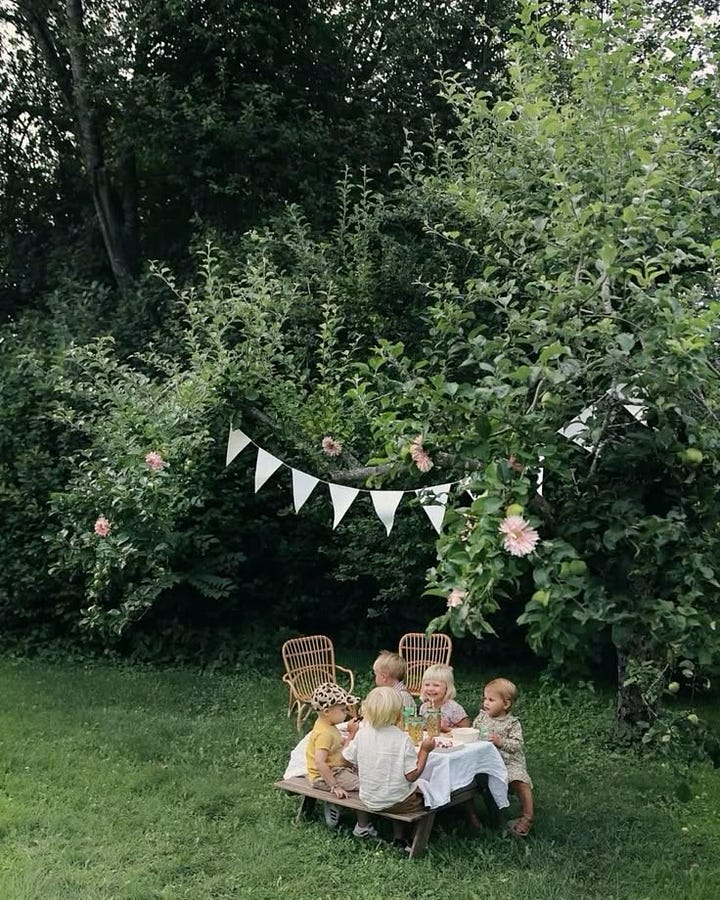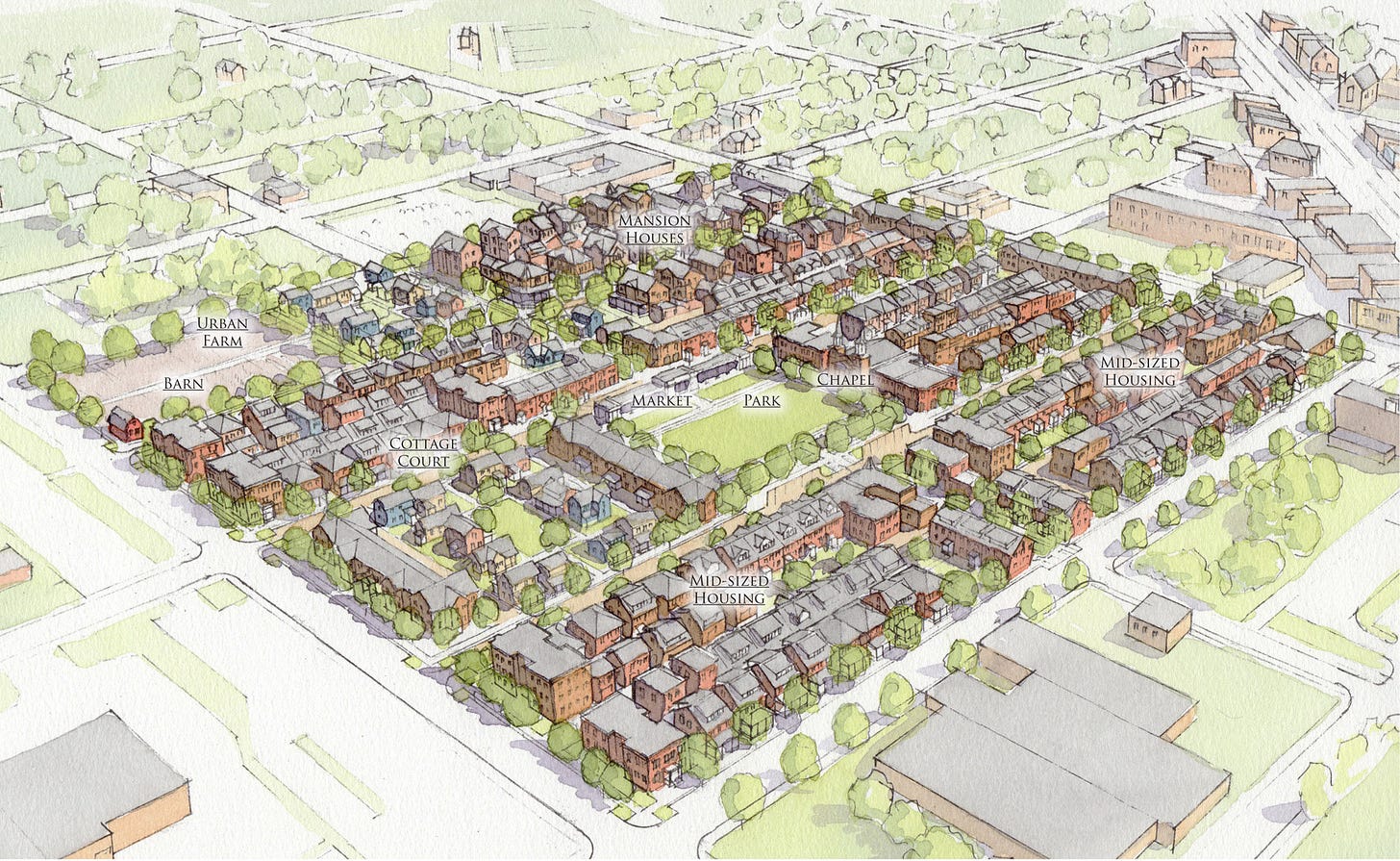Parish or perish
Physical atomization is making parenting harder, motherhood less attractive, and throttling attempts at growing a rooted culture.
In 2024, many dissident commentators started asking themselves how the dissident right could use all the energy that had been built up since the pandemic. At the same time, several commentators pondered how women might fit into the dissident right.
in particular mentioned both in one livestream, "The New Slang". Women orbit around men, the way the moon orbits around the sun. Men choose religion/ideology, and women put it into practice in the home. Men bless the meal at the table, women make sure there is a meal to bless. So in theory, if men move rightward women should eventually follow. But that doesn’t seem to be happening, with even female commentators from within the dissident right space making moves to the left in 2024. Dave theorized that perhaps this is because the “vibes” around the dissident right. I think that there may be something to this.Women are vibes-based creatures. They make a lot of aesthetic judgements, and the aesthetics of the dissident right are not woman-friendly. There is nothing inherently wrong with that. Like Dave pointed out in his podcast, “the only real politics are masculine politics.” No one is trying to convince women to become the next JD Vance. The problems the dissident right is tackling, however, are not purely political. The dissident right is trying to reconstitute healthy culture and community, a project in which women are essential. Women are essential in the transmission of values and cultural norms to children, and they are an essential part of community-building (almost every potluck I’ve been to was organized by a woman). Homemaking is probably the closest word we have to describe this important role. Unfortunately, “homemaking” has a marketing problem.
When you are trying to encourage women to be homemakers, you are fighting against the Tiktok above. It’s not that women don’t want to get married and have kids (when surveyed, they say they want ~2 kids), it’s that they have a hard time imagining an attractive, high status way to do it. As
so aptly put it, “It’s embarassing to be a stay at home mom.” In the popular imagination, homemaking has been reduced to an indentured cook and maid role, an isolating experience where you slave away in the kitchen, totally cut off from friendship, hobbies, and everything else that makes life enjoyable. I think this perception has more to do with the way our society is set up than anything else. As said, “domestic chores have a radically different emotional valence if [a woman] does them with a friend.” explored what this looks like in his series “The Amish Fertility Miracle”:“A common job for young Amish girls is working as a “maid” to help a new mother with housework at the end of pregnancy and for the first few months after childbirth. All new mothers can get this type of help if they want, and it will usually be a younger sister, cousin, or niece of appropriate age. Otherwise the community will find a suitable girl who’s available for the job. A “maid” will sometimes travel to a different Amish community for this reason, given how large extended families are and how frequently Amish families move across the country to a different community.”
“Amish children grow up surrounded by siblings, observing, and as they get older, helping with the care and maintenance of a large family. All their relatives, cousins and extended family are also likely to belong to large families. The average Amish child grows up with dozens of first cousins, and sometimes hundreds of more distant cousins, many of whom they likely know well and socialize with regularly.”
“Weddings and funerals are the main social functions other than church services, and people are expected to attend as many as possible among their family and extended family, regardless of the distance. Given the large family sizes, most Amish have dozens of first cousins and many more distant cousins. Weddings and funerals can be almost weekly events. These are church events as well, so much of the local Amish community will usually attend. It will be an all day event, with the women and girls preparing a lunch and dinner for everyone.”
, The Amish Fertility Miracle, Part 1
The picture
paints in his article is one of a community where homemaking is a valued and central role, and one that is anything but lonely. While the activities involved in homemaking aren’t really any different from those imagined as horrifying by women in mainstream society (cooking, cleaning, raising children), the “emotional valence” of the activities is completely different. Even women who have left cults and extremist sects like Gloriavale and the Fundamentalist Latter Day Saints (FLDS) will often say that while they are very happy to have escaped forced (often child) marriages, they do miss the closeness and community they had within the sect. These are incredibly valuable things, and things that modern society by its very design cannot provide. I think that providing women status, value, and companionship in the pursuit of family will be an important area of focus for groups that want to attract women. This will involve creating alternative status hierarchies1 that are lived out in cohesive communities.Much like religion, however, you can’t create a living community out of whole cloth. There is no “one weird trick” to spontaneously generate a meaningful community.
, , and others discussed this in a recent Twitter Space on “Community Weaving”. One of the primary challenges they identified with organizing is that everyone is too spread out. They would like to spend more time with people they have met online who share their values, but they also have families and cannot realistically spend time every weekend with people who live 1 to 2 hours away. This is a common issue, even in what might be considered more “organic” groups of people. For example, I once spoke to a member of a Reformed church in Ontario who told me their members commute an hour on average to attend. This means that any two members of that congregation might live up to two hours apart! In many cases, the way this plays out is that the church is able to provide lots for young single people who can commute 2 hours a day multiple times a week, but young families are left in a vacuum when it comes to securing support from fellow members. This, in turn, makes homemaking isolating and far less attractive than it should be. You can say that you value homemaking and motherhood, but if your community doesn’t allocate any resources to it, you are communicating that it isn’t that important to you after all.Groups that are set up to support motherhood and homemaking will have to be physically concentrated (and rooted) in a place. Community develops organically out of people of similar faith and culture who pray, work, and play together. To have a community you will, at minimum, need a neighbourhood. Your community needs to be set up in ways that allow for spontaneous interaction with other community members. If the barrier to socialization is anything more than a ten minute walk, odds are it will happen only a couple of times a month, if at all. When a neighbourhood actually does equate with a community, the savings in time, stress, and general overhead are difficult to overstate. Imagine what it would be like to be able to send your kids over to the neighbours’ for a spontaneous playdate if something came up and you were in need of childcare. Imagine how much happier your wife would be if she could go for walks with her friends, or have them over for coffee in the morning, without having to get everyone in the car. In many ways, a “community” that has to drive to see each other isn’t really a community at all.
American subcultures that place a high value on motherhood, like the Amish and Orthodox Jews, have this figured out. The Orthodox Jews are notorious for having dense, concentrated neighbourhoods, which are practically a religious requirement since they are required to walk to synagogue on their sabbath. While the Amish are more rural, and more spread out as a result, they are still all concentrated in a few counties. When they create a new colony, they don’t send a single family and ask them to drive their horse and buggy four hours a day to attend social functions. Instead, they send six families at once who all move in next to each other. For both of these groups, proximity is key to promoting community cohesion and allowing for mutual support. It’s probably not a coincidence that these two subcultures are also the highest fertility groups in the United States.
I suspect that this clustering of members of the same ethnoreligious group was probably the norm historically for all of North America. One thing visitors to Quebec often remark to me is how “walkable” and “European” it is. This is completely by design. Aside from a few new cancers suburbs like Laval, Quebec is largely still organized how it was built originally- according to the parish system. Villages were organized around the church. Its tall bell tower was the highest and focal point of the surrounding area, and everything was concentrated around it. Since most people didn’t have cars well into the 1950s, they had to either take a horse and buggy (or sleigh) or walk to church. This meant that people lived, more or less, in walking distance from one another. Even on farms, people tend to live closer together than in English Canada, because in Quebec the land was sliced and assigned in long, vertical strips. So even if you have a huge plot of land, your house is probably not that far from your neighbour’s.
It seems that the next project, for groups with the resources and dedication to undertake it, is the reconstruction of communities that follow the parish model. St. Joseph’s Shrine is an Institute of Christ the King parish located in Detroit, Michigan. The institute was invited into the ruins of the city by the diocese in 2016, and since then, the parish has grown substantially. Currently however, most parishioners are commuters, living between thirty and forty minutes away from the church in one of Detroit’s many suburbs. It seems like church leaders are trying to change this, however. In 2021, the church began floating the idea of buying up some of the cheap, abandoned land nearby to develop into a neighbourhood where parishioners could work and live.2 The plan, called “St Aubin’s Village” includes a market, park, various types and sizes of housing, and even an urban farm.3 The sketches by the urban designer responsible for pitching the development are notable, because they seem not only practical, but also beautiful.
While St. Aubin’s Village does not seem to have been given the go-ahead quite yet, in 2024 St. Joseph’s Shrine announced that it had acquired a large plot of land directly next to the church. The land will be developed into a park, school, and parish hall to be used in functions like wedding receptions.4 Hopefully, this is just the beginning of the transformation of a derelict area into a living, breathing, Catholic community. In my opinion, projects like these are what will ultimately make homemaking appealing again. With vibes like these, who needs girlbossing?




In most mainstream North American cultures, it’s high status to have for women to have a career and low status to have kids. See
’s “It’s embarrassing to be a stay-at-home mom”








This is a pretty good relfection on the development of intentional communities. There are big tensions in the intellectual space of the online right between organization for the sake of development of pro-social communities, and organization for the sake of forming men into units that will, in future, be capable of political action.
All of what you’ve described here addresses the re-construction of organic community for the eudomonic purposes. This is how people are meant to live. When I look at my own religious community; with high birth rates, intact families with good relationships spanning 3 generations, and a deep spiritual life, you can see a lot of what your describing here. Communities like mine are fundamentally in need of a layer of organized intellegent men to give them a leadership class. Where in the broad culture, a lot of the horrendous social problems they have realy reqquire the building of pro-social primary communities to address.
Souns nice but we’re not only against girl’s boss vibes but also the glitter of Star Academy, hookup culture, entertainment in general and the managerial totalitarian state… Self reliant tightly knitted community finding meaning and purpose in a common struggle for survival is a tough sell but I guess you have to start somewhere.